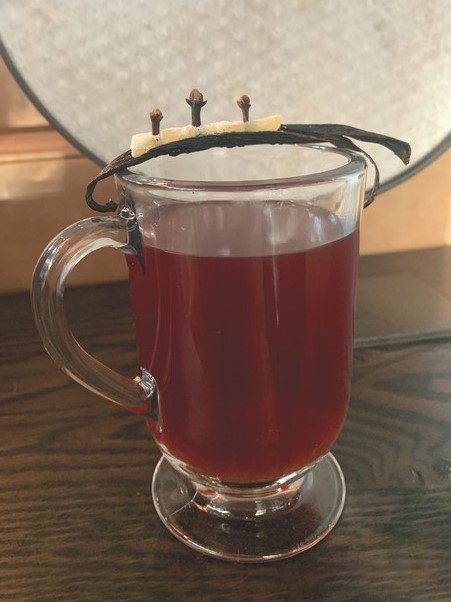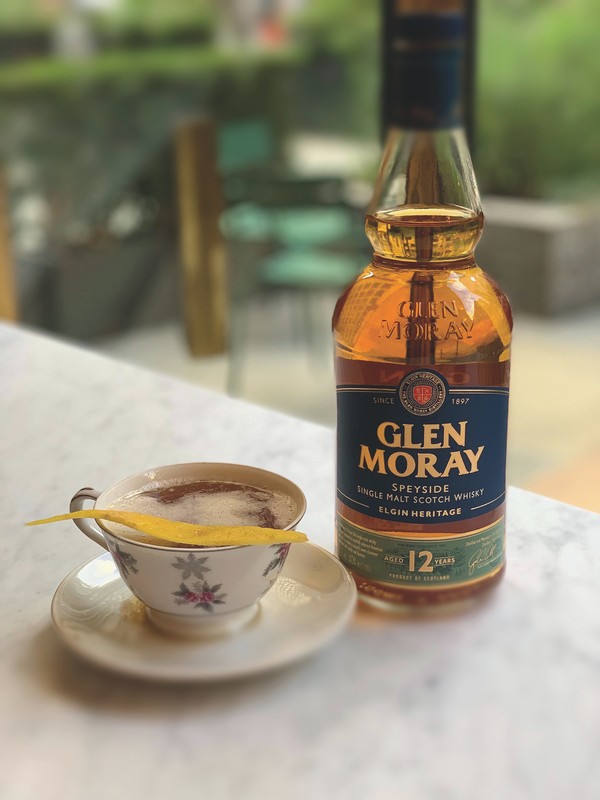
As the pandemic persists, outdoor dining may very well be as important this winter as it was last—and what better way to warm up on a chilly patio than with a hot cocktail. “I love the fact that a hot drink keeps your hands warm—you can enjoy the nice winter chill while staying cozy with every sip,” says Enrique Nabor, bartender at The Lobby in the Ace Hotel in Chicago. Indeed, where summer is all about light and refreshing coolers to beat the heat, winter welcomes the opportunity for warming classics like Hot Toddies, Irish Coffees, mulled drinks, and more.
Hot cocktails are a surefire way to please guests during winter, notes Leah Carricato, senior operations manager with Captivate Hospitality Group, which owns the restaurant Solstice in Newtown, Pennsylvania and Irvine, California. “There’s something extra comforting about having a warm drink in the cooler months, so knowing that we can make a guest more comfortable with a warm and delicious cocktail always makes us feel good,” she says. “Making anything that makes people happy is always the best part of being in the business of people.”
Carricato adds that a decade or two ago hot cocktails typically only appeared on dessert menus and tended to be overly sweet. “Now, there’s a place for warm cocktails not just as a nightcap, but as an opportunity to use the warm application to enhance flavors in a different light throughout a guest’s meal or even better, just because that’s the cocktail they want to enjoy while grabbing a drink at the bar with a friend,” she says.

Toddy Twists
The Hot Toddy, which traditionally features whisk(e)y, hot water, honey, and lemon and is said to help relieve cold symptoms, is perhaps the best-known winter warmer. “It’s the original hot cocktail and goes back to the 18th century or earlier—it was especially popular with early settlers in the cold American winters,” says Scott Harris, general manager and co-founder of Catoctin Creek Distilling Co. in Purcellville, Virginia. “The earliest cocktails were very simple, but now, modern versions featuring fancier liqueurs, bitters, and exotic spices and fruits have made these drinks more adventurous.”
Indeed, today’s bartenders have fun putting their own spin on the classic Toddy build. At Ace Hotel’s The Lobby, for instance, Nabor’s Hot Toddy ($14) features Rittenhouse Rye whiskey, Courvoisier Cognac, Plantation 3 Stars rum, house-made ginger syrup, lemon juice, and hot water. Also a Toddy variation, his Low & Slow ($14) comprises Rittenhouse, Laird’s Straight Apple brandy, house-made ginger syrup, honey, lemon, and hot water. “Hot Toddies are definitely the most popular with our guests during the winter, but you have to make sure you have the water ratio correct, otherwise you risk the cocktail losing all of its flavors compounds,” Nabor notes.
He adds that bartenders are getting more and more creative with even the most standard recipes. “From infusing and aging to modifying older recipes with newer or trendier ingredients, bartenders are pushing hot cocktails in a more modern direction,” he says. At NR in New York City, owner and bar director Shigefumi Kabashima offers various takes on the traditional Toddy: His Japanese Toddy ($16) blends Nikka Coffey Grain whisky, yuzu juice, kuromitsu—a Japanese black sugar syrup—and hot water; his Bee + Chamomile ($16), which is warmed in a soup kettle, mixes chamomile-infused Gordon’s London Dry gin, honey, grapefruit and lemon juices, and orange blossom water; and his Nightcap ($16) is warmed in a Turkish coffee pot and features Green Chartreuse, honey, fresh ginger, lemon juice, water, and butter.

At Solstice, the Solstice Toddy ($14) blends Four Roses Bourbon, Combier Liqueur De Banane banana liqueur, Nocello Walnut liqueur, lemon juice, hot water, and mint. “Our warm cocktails have been really well received by our guests, but our Solstice Toddy has been a stand out,” Carricato says. “It’s warm and comforting with notes of walnut, banana, and Bourbon but with a surprising refreshing element with the aroma of the mint and brightness from the lemon.” Another popular warm drink at Solstice that’s Toddy adjacent but also distinctly its own is the Tea Service ($14), which mixes Leblon Cachaça, Aperol aperitif, house-made turmeric ginger tea syrup, hot water, and Peychaud’s bitters.
“Bartenders and drink creators have gotten more creative and started to go beyond the basic Toddy template,” says Stacey Swenson, beverage director for the New York City-based restaurant group Matter House. “Hot cocktails can lack complexity because so much water has to be added, so instead of adding just hot water, I like adding tea to create more layers of flavor. Also, not every hot winter cocktail has to have warming spices—if you’re able to offer more than one hot drink on your menu they don’t all need cinnamon, allspice, nutmeg, and star anise.” At Matter House’s new concept Caffe Lodi at 1 Rockefeller Plaza, Swenson’s Scot’s Tea ($15) features Glen Moray 12-year-old Scotch, Italicus Rosolio di Bergamotto bergamot liqueur, honey syrup, lemon juice, and hot Earl Grey tea.
“Tea is a great inspiration to work from when making warm drinks,” says Ariana Vitale, beverage director at Abigail Hall in Portland, Oregon. “Also, don’t be afraid to take ingredients that are typically from summer and spring to draw into your winter flavors. Baking spices go great with tropical fruit.” Her Nightmare Before Christmas ($13) comprises Ron Zacapa 23 Centenario rum, Ancho Reyes ancho chile liqueur, passion fruit syrup made by a local commissary kitchen, Demerara simple syrup, hot Steven Smith Big Hibiscus tea, and a dash of Nielsen-Massey Madagascar Bourbon pure vanilla extract.

Sweet And Spiced
Although any number of different spirits, ingredients, and spices can be used to make a delicious hot cocktail, darker aged spirits and baking spices remain very popular choices— and for good reason. “Hot cocktails are most enjoyable in the winter when baked goods are also in their prime, and this is mirrored pretty closely in many hot cocktails,” says Blaze Laroe, beverage director at Chikatana in Chicago. “People usually gravitate toward baking spice flavors and the most popular spirit is usually some sort of whisk(e)y, which gets its vanilla flavor from resting in oak barrels. Pair the natural vanilla flavor from whisk(e)y with some cinnamon, cloves, allspice, and/or star anise, plus some sugar, and you’ve got yourself a great hot cocktail.” Whiskies are indeed very common in wintertime drinks, and the classic Irish Coffee build of Irish whiskey, hot coffee, sugar, and whipped cream provides a delicious blueprint. At Solstice, the Spiked Coffee ($12) features Four Roses Bourbon, simple syrup, vanilla extract, and hot coffee, topped with whipped cream and edible glitter, and at Barn8 Farm Restaurant & Bourbon Bar in Goshen, Kentucky, bar manager Randi Densford’s Cowgirl Coffee ($12) blends Rittenhouse Rye, hot coffee, house-made spiced walnut syrup, and house-made spiced coconut cream.
Apple cider is another common ingredient in hot cocktails, as its sweetness and baking spice notes pair well with a range of aged spirits. At NR, Kabashima notes that a popular warm drink among guests is his Apple ($16), which comprises Buffalo Trace Kentucky Straight Bourbon, apple cider, honey, house-made Angostura bitters, butter, and cinnamon, all of which are warmed in a soup kettle before serving. “My favorite combinations for hot drinks always involve rye whiskey, which gives a nice spicy backbone to cocktails,” Catoctin Creek Distilling Co.’s Harris says. At the distillery’s tasting room, Harris’ Mulled Hot Rye Cider ($12) features Catoctin Creek Roundstone rye plus apple cider that’s been heated with satsuma oranges, honey crisp apples, cinnamon sticks, and cloves, resulting in a fragrant and warming sipper.

“One of my personal favorite hot beverages is the grog, which traditionally was simply rum, water, and lemon, and is one of the first ever-recorded cocktails—it provided sailors of the 18th century with enough vitamin C to stave off scurvy on long voyages,” Laroe says. “Bartenders have since modernized the recipe in every shape and form. From blending rums, adding sugar and juices, and serving it hot or cold, grog has fully evolved and is the inspiration behind countless cocktails.” His Autumn Harvest ($13) is one such drink, mixing Ten To One Dark blended rum, St. Elizabeth allspice dram, and house-made hot cider that comprises local apples, cinnamon, star anise, cloves, lemon juice and zest, dark brown sugar, and water. “This rendition of grog keeps its simple roots but brings fresh, seasonal produce into the mix,” Laroe adds. “Living in the Midwest gives us plenty of access to apples in the fall—in our cider I use both Mcintosh, which provides the quintessential apple flavor, and Granny Smith, which provides a refreshing tartness. Then for the base of the Autumn Harvest I use a blended rum for a well-rounded sweetness and a hint of funk.”
Chikatana will also be serving a traditional Ponche ($13)— the Latin American iteration of punch—this winter. It’s a mulled concoction of dried hibiscus flowers, piloncillo sugar, tejocotes, raisins, dried apricots, guava, pineapple, cinnamon, star anise, cloves, and water. It’s served with the guest’s choice of spirit, but Laroe prefers mezcal—specifically Fidencio Classico. “It has some nice roasted qualities with the pleasant zing of acidity that I love in a good mezcal,” he says.
Captivate Hospitality Group’s Carricato notes that she’s looking forward to seeing more mezcal and Tequila in warm winter cocktails this year. “As they’ve both risen in popularity and become acceptable beyond a shot with salt and lime, it’s really exciting to see them being used in applications across the board, including in warm cocktails,” she says. At Freight House in Paducah, Kentucky, proprietor and chef Sara Bradley’s The Cocoa Diablo ($12) blends Xicaru Silver mezcal, Tempus Fugit Crème de Cacao liqueur, Woodford Reserve Chocolate bitters, and hot water. And at Chef Adrianne’s Vineyard Restaurant & Bar in Miami, owner and chef Adrianne Calvo’s Haute Hot Chocolate ($18) features Señorío Joven mezcal plus a house-made cocoa that includes cinnamon and ancho chile for added kick, topped with whipped cream, dark chocolate shavings, chile powder, and a cinnamon stick.
“I think that hot cocktails have evolved in recent years because there are now more ingredients to choose from and more techniques for warming,” NR’s Kabashima says. At Lost Property Bar in Los Angeles, bartender Rhino Williams uses a steam wand from an espresso machine to heat up his To Sing a Coconut Carol ($14), which blends Paul John Nirvana Indian Single Malt whisky, coconut milk, house-made ginger syrup, and maple syrup, topped with a pinch each of black pepper, turmeric, and cinnamon. “I love seeing the reaction of whoever is drinking one of my hot cocktails,” Williams says. “There’s almost a coziness and relaxation to their expression, if only for a millisecond. That’s what making hot cocktails has always meant to me.”


